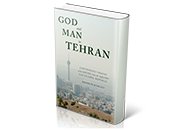Description
God and Man in Tehran: Contending Visions of the Divine from the Qajars to the Islamic Republic
The explorations presented in this book are historical, not theological, metaphysical, or religious, in both purview and purpose. The objective is neither to prove any theological propositions nor to disprove any metaphysical principles; neither to discover and expose the existence or nonexistence of primary truths or immutable essences nor to justify the dogmatic origins of concepts or delineate their consequences. God and Man in Tehran is a disclaimer: Neither a polemic nor an apology, this inquiry does not settle age-old philosophical, theological, or religious scores.
Rather, the goal of God and Man in Tehran is to illustrate how certain ideas have been made, unmade, and remade within the geographic and historical confines of the city of Tehran. In this book, several positions will be framed successively in seven chapters. These views are interrelated in different ways, sometimes imbricating and convergent, sometimes discordant and diffusive, but always mirroring the concrete conditions that engender and sustain them. What Tehranis have believed or disbelieved reflects the ideals, anxieties, ambiguities, and ironies built or transpierced into their history.
Chapter 1 surveys the impact of modern natural science on related conceptions of reason, law, religion, and art. Introducing the term “mediatory theology” as a comparative rubric, chapter 2 discusses the historical unfolding of pertinent debates on the agentive relationship between God and the world. Besides the dominant majority Shia Muslim population of the city, the views of other faith groups inform this presentation—the thousands of Armenian and Assyrian Christians, Jews, Sunni Muslims, Zoroastrians, Bahais, and the Ahl-e Ḥaq (People of the Truth). Chapter 3 continues by enumerating some God-oriented beliefs and practices that shaped the quotidian routines of ordinary women and men in Tehran. Of course, the intellectual elite often opined that the common folks’ understandings of the real issues involved were inadequate, quaint, or outright incoherent. The following four chapters outline some aspects of more theoretically systematic disciplines that define the turfs of the expert elite. First comes an elaboration on perceived relations between the law of God and man-made
legislation in chapter 4. As early as the 1810s, Tehran began to have religious madrasahs—educational institutions for the ʿolamā. While law and jurisprudence formed the core of the curriculum in madrasahs, there was also room for metaphysical knowledge or madrasah philosophy. This is the
topic of chapter 5. Then chapter 6 follows with an overview of the development of some mystical ideas associated with Sufism. Finally, chapter 7 turns to religious skepticism and some other more recent theological developments. Ever since Tehran first rose to prominence, people of diverse walks of life embraced myriad beliefs about God. Where some stood unshakable in their convictions, others wavered in theirs. Looking at the expressions of theological skepticism, revisionism, and reformism, the last
chapter of God and Man in Tehran draws attention to the discursive negative space that surrounds the many views encountered in the preceding ones.
Hossein Kamaly is an Associate Professor of Islamic Studies at Hartford Seminary. A scholar of the Middle East, focusing on the history of ideas, he has previously taught at Barnard College and Columbia University and is the author of God and Man in Tehran. He lives in New York.
Additional information
| Author | HOSSEIN KAMALY |
|---|---|
| Place | New York |
| Publisher | Columbia University Press |
| Date | 2018 |
| Pages | 255 |
| Bibliography | Kamaly, Hossein, God and Man in Tehran: Contending Visions of the Divine from the Qajars to the Islamic Republic, New York, Columbia University Press, 2018. |


